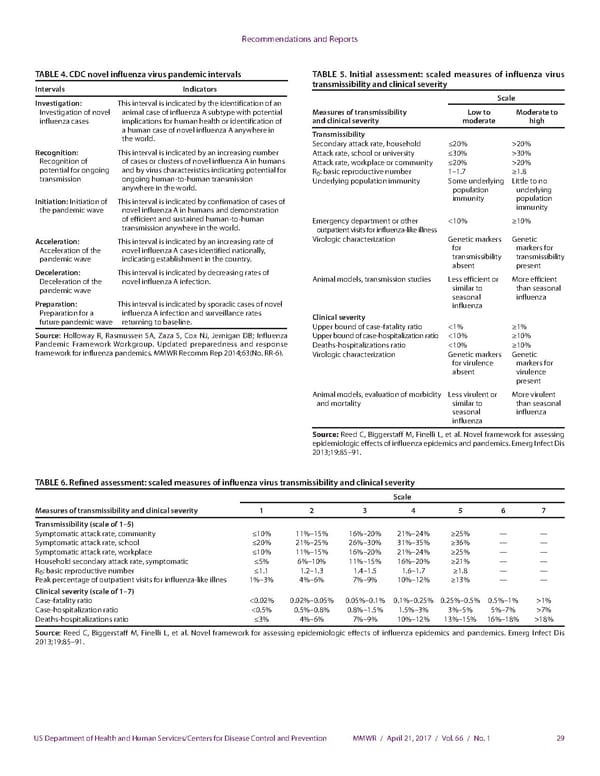Recommendations and Reports TABLE 4. CDC novel influenza virus pandemic intervals TABLE 5. Initial assessment: scaled measures of influenza virus Intervals Indicators transmissibility and clinical severity Investigation: This interval is indicated by the identification of an Scale Investigation of novel animal case of influenza A subtype with potential Measures of transmissibility Low to Moderate to influenza cases implications for human health or identification of and clinical severity moderate high a human case of novel influenza A anywhere in Transmissibility the world. Secondary attack rate, household ≤20% >20% Recognition: This interval is indicated by an increasing number Attack rate, school or university ≤30% >30% Recognition of of cases or clusters of novel influenza A in humans Attack rate, workplace or community ≤20% >20% potential for ongoing and by virus characteristics indicating potential for R : basic reproductive number 1–1.7 ≥1.8 0 transmission ongoing human-to-human transmission Underlying population immunity Some underlying Little to no anywhere in the world. population underlying Initiation: Initiation of This interval is indicated by confirmation of cases of immunity population the pandemic wave novel influenza A in humans and demonstration immunity of efficient and sustained human-to-human Emergency department or other <10% ≥10% transmission anywhere in the world. outpatient visits for influenza-like illness Acceleration: This interval is indicated by an increasing rate of Virologic characterization Genetic markers Genetic Acceleration of the novel influenza A cases identified nationally, for markers for pandemic wave indicating establishment in the country. transmissibility transmissibility absent present Deceleration: This interval is indicated by decreasing rates of Deceleration of the novel influenza A infection. Animal models, transmission studies Less efficient or More efficient pandemic wave similar to than seasonal seasonal influenza Preparation: This interval is indicated by sporadic cases of novel influenza Preparation for a influenza A infection and surveillance rates Clinical severity future pandemic wave returning to baseline. Upper bound of case-fatality ratio <1% ≥1% Source: Holloway R, Rasmussen SA, Zaza S, Cox NJ, Jernigan DB; Influenza Upper bound of case-hospitalization ratio <10% ≥10% Pandemic Framework Workgroup. Updated preparedness and response Deaths-hospitalizations ratio <10% ≥10% framework for influenza pandemics. MMWR Recomm Rep 2014;63(No. RR-6). Virologic characterization Genetic markers Genetic for virulence markers for absent virulence present Animal models, evaluation of morbidity Less virulent or More virulent and mortality similar to than seasonal seasonal influenza influenza Source: Reed C, Biggerstaff M, Finelli L, et al. Novel framework for assessing epidemiologic effects of influenza epidemics and pandemics. Emerg Infect Dis 2013;19:85–91. TABLE 6. Refined assessment: scaled measures of influenza virus transmissibility and clinical severity Scale Measures of transmissibility and clinical severity 1 2 3 4 5 6 7 Transmissibility (scale of 1–5) Symptomatic attack rate, community ≤10% 11%–15% 16%–20% 21%–24% ≥25% — — Symptomatic attack rate, school ≤20% 21%–25% 26%–30% 31%–35% ≥36% — — Symptomatic attack rate, workplace ≤10% 11%–15% 16%–20% 21%–24% ≥25% — — Household secondary attack rate, symptomatic ≤5% 6%–10% 11%–15% 16%–20% ≥21% — — R : basic reproductive number ≤1.1 1.2–1.3 1.4–1.5 1.6–1.7 ≥1.8 — — 0 Peak percentage of outpatient visits for influenza-like illnes 1%–3% 4%–6% 7%–9% 10%–12% ≥13% — — Clinical severity (scale of 1–7) Case-fatality ratio <0.02% 0.02%–0.05% 0.05%–0.1% 0.1%–0.25% 0.25%–0.5% 0.5%–1% >1% Case-hospitalization ratio <0.5% 0.5%–0.8% 0.8%–1.5% 1.5%–3% 3%–5% 5%–7% >7% Deaths-hospitalizations ratio ≤3% 4%–6% 7%–9% 10%–12% 13%–15% 16%–18% >18% Source: Reed C, Biggerstaff M, Finelli L, et al. Novel framework for assessing epidemiologic effects of influenza epidemics and pandemics. Emerg Infect Dis 2013;19:85–91. US Department of Health and Human Services/Centers for Disease Control and Prevention MMWR / April 21, 2017 / Vol. 66 / No. 1 29
 Community Mitigation Guidelines to Prevent Pandemic Influenza Page 30 Page 32
Community Mitigation Guidelines to Prevent Pandemic Influenza Page 30 Page 32